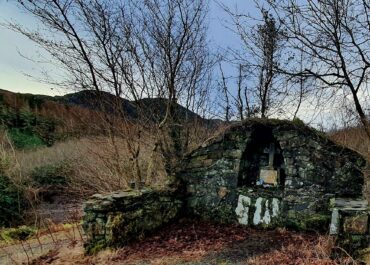Graveslab, Ballysaggart, Co. Donegal
Set against the western gable of St. Catherine's Catholic Church in Killybegs stands a remarkable medieval tomb slab that tells a story of Ireland's turbulent past.
Graveslab, Ballysaggart, Co. Donegal
This trapezoidal sandstone monument, measuring nearly two metres in length, was relocated here in 1868 from its original home at Fan an Chartha friary on St John’s Point. The slab’s surface is divided into nine intricate panels by bands of ribbon interlacing, all carved in shallow false relief that has weathered over the centuries but still reveals fascinating details of 16th century artistry.
The left side of the slab features a striking figure of a gallowglass, one of the elite mercenary warriors who served Irish lords during the medieval period. Helmeted and plumed, he grips a battle axe whilst a sword hangs at his side, dressed in what appears to be a mail coat belted at the waist and reaching to his knees. Below him, panels display opposing beasts standing on stylised foliage, interlacing designs, and two figures locked in combat. The imagery speaks to both the martial culture and the artistic sophistication of the time, combining Celtic interlace patterns with figurative representations.
The right side continues the decorative programme with cusped ogival ovals, more interlace work, and curiously, what appear to be naked interlocking figures in the fourth panel, topped off with a stylised vine leaf design. Though no inscription survives, local tradition connects this elaborate monument to the McSwyne family, whose castle ruins still stand at Rahan Near on the western side of St John’s Point. The slab serves as a tangible link to Donegal’s medieval past, when Gaelic lordships employed foreign mercenaries and commissioned elaborate stone monuments that blended native Irish artistic traditions with continental influences.


